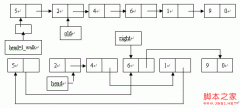C / C++的和Java的异常机制[组图]
程序总会出现异常的,需要我们去处理。C++和Java都有自己异常机制,我们应该遵循着去处理异常。那它们的异常机制有何异同呢?
要注重一点:异常机制处理异常是要付出代价的,即异常处理的代码比无异常处理的要慢好多倍。
JAVA的异常机制
在面向对象的世界里,一切都是对象,JAVA的异常也不例外。API中异常类的“始祖”是 Throwable 类,有 Exception 类和 Error 类直接继续Throwable 。Error是很严重的,是不可拯救的,我们一般是通过继续Throwable 或Exception 来定义自己的异常类。
先看看API(这里是从1.5摘抄的)里的两个异常类是怎样的?
 import java.io.*;
import java.io.*;

 public class Throwable implements Serializable ...{
public class Throwable implements Serializable ...{

 /** *//** use serialVersionUID from JDK 1.0.2 for interoperability */
/** *//** use serialVersionUID from JDK 1.0.2 for interoperability */
 private static final long serialVersionUID = -3042686055658047285L;
private static final long serialVersionUID = -3042686055658047285L;


 /** *//**
/** *//**
 * Native code saves some indication of the stack backtrace in this slot.
* Native code saves some indication of the stack backtrace in this slot.
 */
*/
 private transient Object backtrace;
private transient Object backtrace;
 private String detailMessage;
private String detailMessage;
 private Throwable cause = this;
private Throwable cause = this;
 private StackTraceElement[] stackTrace;
private StackTraceElement[] stackTrace;


 public Throwable() ...{
public Throwable() ...{
 fillInStackTrace();
fillInStackTrace();
 }
}


 public Throwable(String message) ...{
public Throwable(String message) ...{
 fillInStackTrace();
fillInStackTrace();
 detailMessage = message;
detailMessage = message;
 }
}


 public Throwable(String message, Throwable cause) ...{
public Throwable(String message, Throwable cause) ...{
 fillInStackTrace();
fillInStackTrace();
 detailMessage = message;
detailMessage = message;
 this.cause = cause;
this.cause = cause;
 }
}


 public String getLocalizedMessage() ...{
public String getLocalizedMessage() ...{
 return getMessage();
return getMessage();
 }
}


 public Throwable getCause() ...{
public Throwable getCause() ...{
 return (cause==this ? null : cause);
return (cause==this ? null : cause);
 }
}


 public synchronized Throwable initCause(Throwable cause) ...{
public synchronized Throwable initCause(Throwable cause) ...{
 if (this.cause != this)
if (this.cause != this)
 throw new IllegalStateException("Can't overwrite cause");
throw new IllegalStateException("Can't overwrite cause");
 if (cause == this)
if (cause == this)
 throw new IllegalArgumentException("Self-causation not permitted");
throw new IllegalArgumentException("Self-causation not permitted");
 this.cause = cause;
this.cause = cause;
 return this;
return this;
 }
}


 public String toString() ...{
public String toString() ...{
 String s = getClass().getName();
String s = getClass().getName();
 String message = getLocalizedMessage();
String message = getLocalizedMessage();
 return (message != null) ? (s + ": " + message) : s;
return (message != null) ? (s + ": " + message) : s;
 }
}


 private synchronized StackTraceElement[] getOurStackTrace() ...{
private synchronized StackTraceElement[] getOurStackTrace() ...{
 // Initialize stack trace if this is the first call to this method
// Initialize stack trace if this is the first call to this method

 if (stackTrace == null) ...{
if (stackTrace == null) ...{
 int depth = getStackTraceDepth();
int depth = getStackTraceDepth();
 stackTrace = new StackTraceElement[depth];
stackTrace = new StackTraceElement[depth];
 for (int i=0; i < depth; i++)
for (int i=0; i < depth; i++)
 stackTrace[i] = getStackTraceElement(i);
stackTrace[i] = getStackTraceElement(i);
 }
}
 return stackTrace;
return stackTrace;
 }
}
 //......省略了一些
//......省略了一些
 }
}

注重一点:异常类是可串行化的。
public class Exception extends Throwable {
static final long serialVersionUID = -3387516993124229948L;
public Exception() {
super();
}
public Exception(String message) {
super(message);
}
public Exception(String message, Throwable cause) {
super(message, cause);
}
public Exception(Throwable cause) {
super(cause);
}
}
一个简单例子:
 public class MyException extends Exception
public class MyException extends Exception

 ...{
...{
 MyException(String str)
MyException(String str)

 ...{
...{
 super(str);
super(str);
 }
}
 }
}

 public class MyTest
public class MyTest

 ...{
...{
 public void f()throws MyException
public void f()throws MyException

 ...{
...{
 throw new MyException("f() exception");
throw new MyException("f() exception");
 }
}
 }
}
 public class Main
public class Main

 ...{
...{
 public static void main(String[]args)
public static void main(String[]args)

 ...{
...{
 try
try

 ...{
...{
 new MyTest().f();
new MyTest().f();
 }catch(MyException me)
}catch(MyException me)

 ...{
...{
 System.out.println(me);
System.out.println(me);
 }finally
}finally

 ...{System.out.println("finally");
...{System.out.println("finally");
 }
}
 }
}
 }
}
假如可能发生多种异常时,可用多个catch语句捕捉不同类型的异常,从第一个catch开始匹配异常,假如异常是该类或该类的子类,则匹配。假如要匹配所有的异常,则在catch中捕捉 Throwable 类,因为其它所有异常类都是其子类,都可匹配。其中 finally块是程序必然会执行的块,除非JVM忽然退出了。
C++的异常机制
在C的时候,错误处理要 setjmp() / longjmp() 通过。而C++里, setjmp() / longjmp() 已经不能用了。C++的异常可以是类,也可以是基本类型(如int)。在标准库中,也存在exception类。但是,C++并没有要求我们自定义的异常要继续某个类。
一个简单例子:
 #include
#include
 using namespace std;
using namespace std;

 #ifndef NULL
#ifndef NULL
 #define NULL 0
#define NULL 0
 #endif
#endif
 class MyException
class MyException

 ...{
...{
 const char * const msg;
const char * const msg;
 public:
public:

 MyException(const char* const _msg=NULL):msg(_msg)...{};
MyException(const char* const _msg=NULL):msg(_msg)...{};
 void print()
void print()

 ...{
...{
C++的异常捕捉匹配和JAVA的基本相同,只是C++没有 finally 块。要捕捉所有异常的方法是用 catch(...) 语句。 以上所述都只是JAVA和C++的异常机制的皮毛。对JAVA的异常,觉得自己理解得还可以,懂得什么是捕捉,什么是抛出异常、传播异常和包装异常等。但是对C++的异常,可以说是刚刚接触,刚才看了 Thinking in C++ 异常处理的一章。想起JAVA的异常机制,就作个对比,写个笔记。 QQread.com 推出游戏功略 http://www.qqread.com/netgame/game/index.Html 魔兽世界 跑跑卡丁车 街头篮球 水浒Q传 龙与地下城OL 征服 轩辕剑5 FIFA07 热血江湖 大唐风云 梦幻西游 武林外传  cout<
cout< }
} };
}; void f()
void f()
 ...{
...{ throw MyException("something bad happened");
throw MyException("something bad happened"); }
}
 int main()
int main()
 ...{
...{ try
try
 ...{
...{ f();
f(); }catch(MyException me)
}catch(MyException me)
 ...{
...{ me.print();
me.print(); }
} system("pause");
system("pause"); return 0;
return 0; }
}
- 上一篇:深入理解C++中的mutable关键字
- 下一篇:Awk 基础入门:Awk 实例编程





